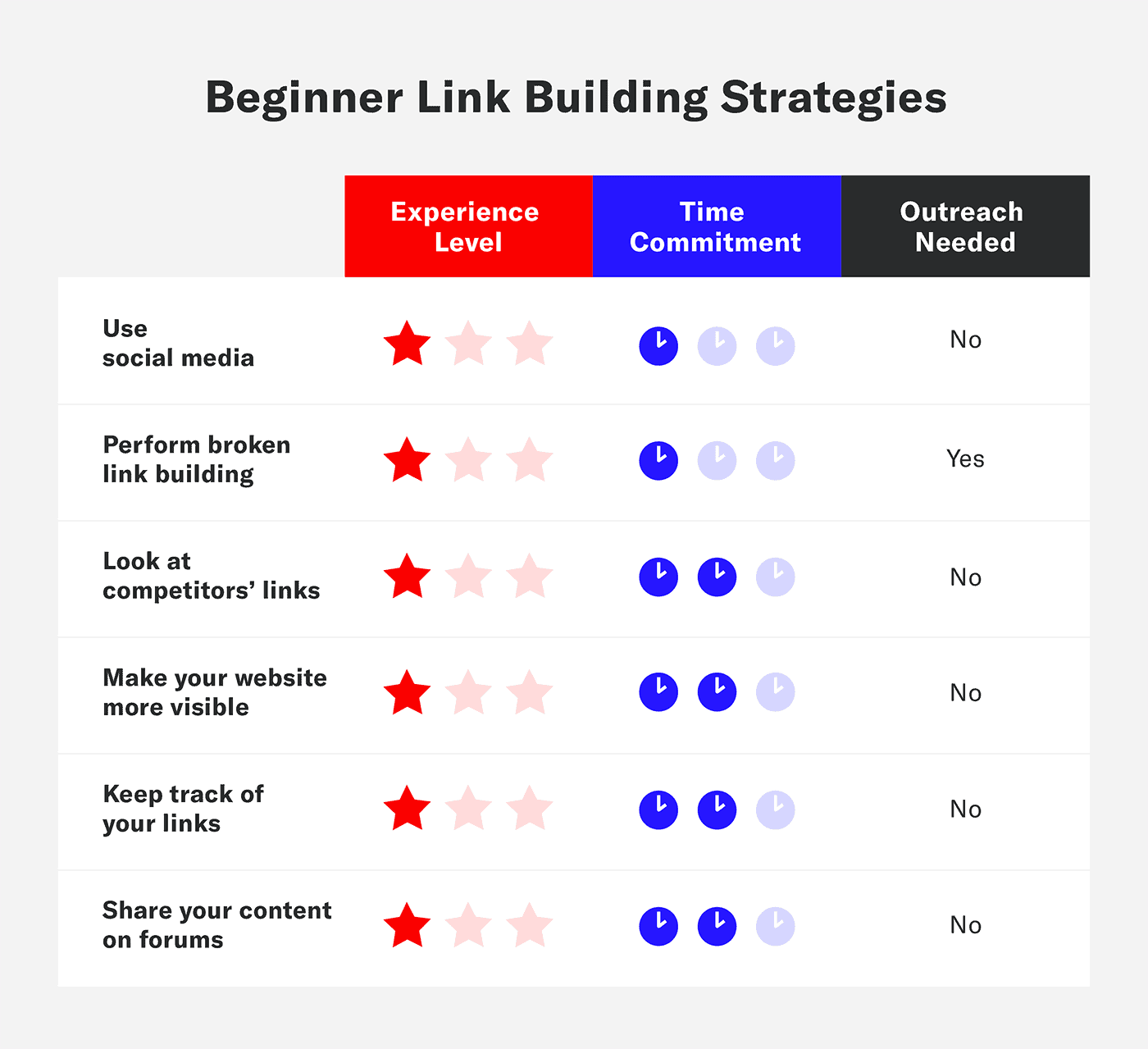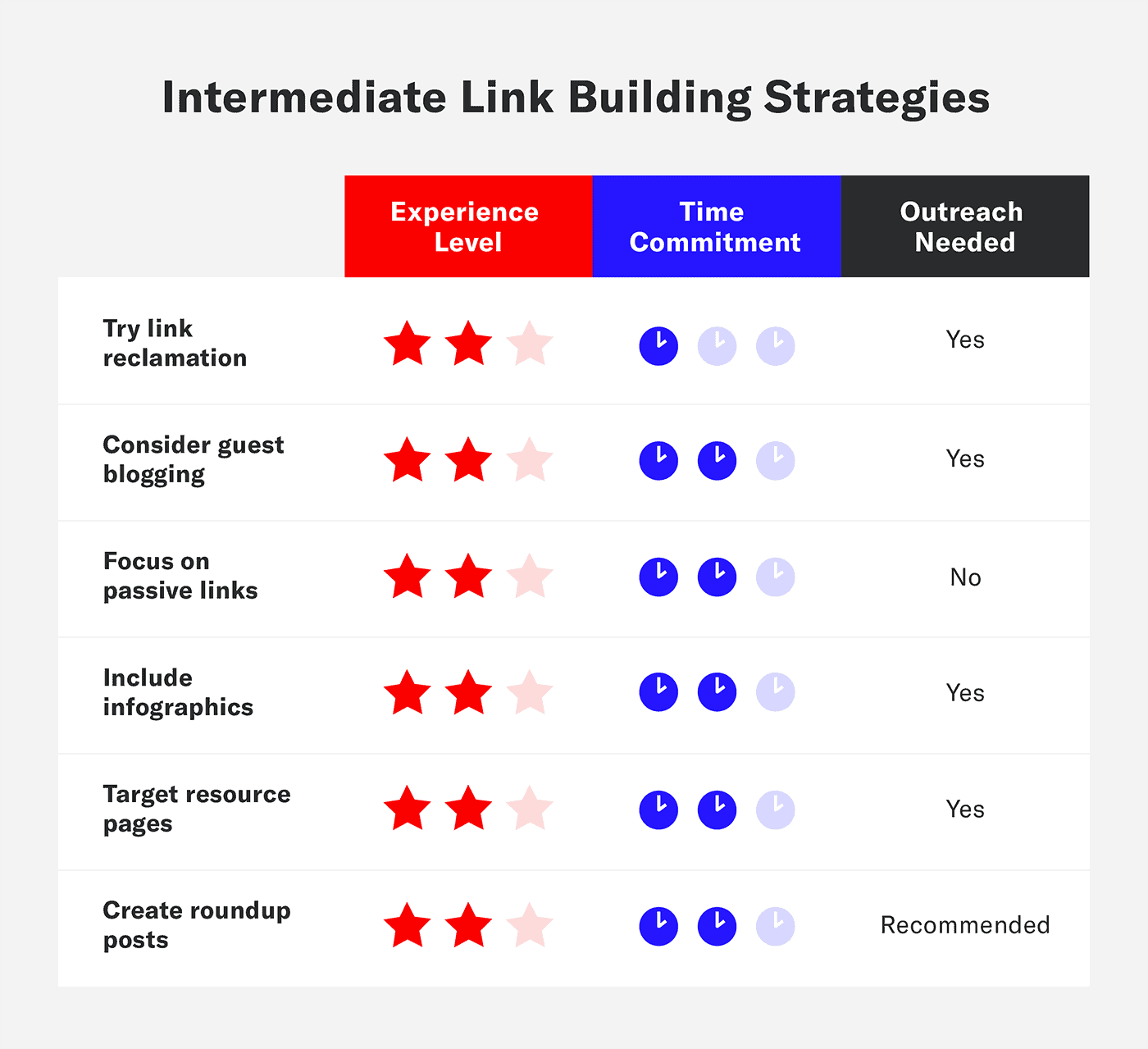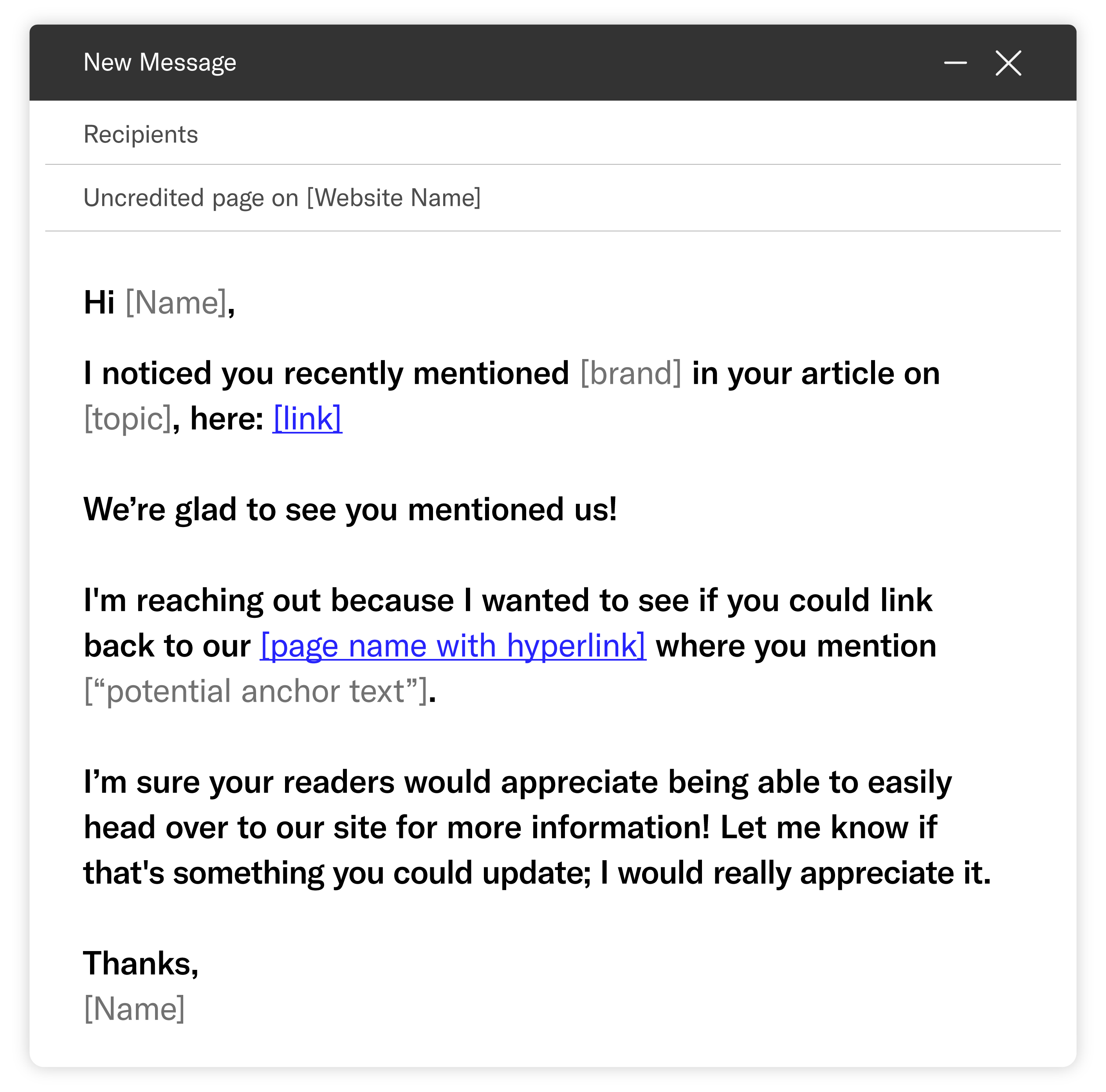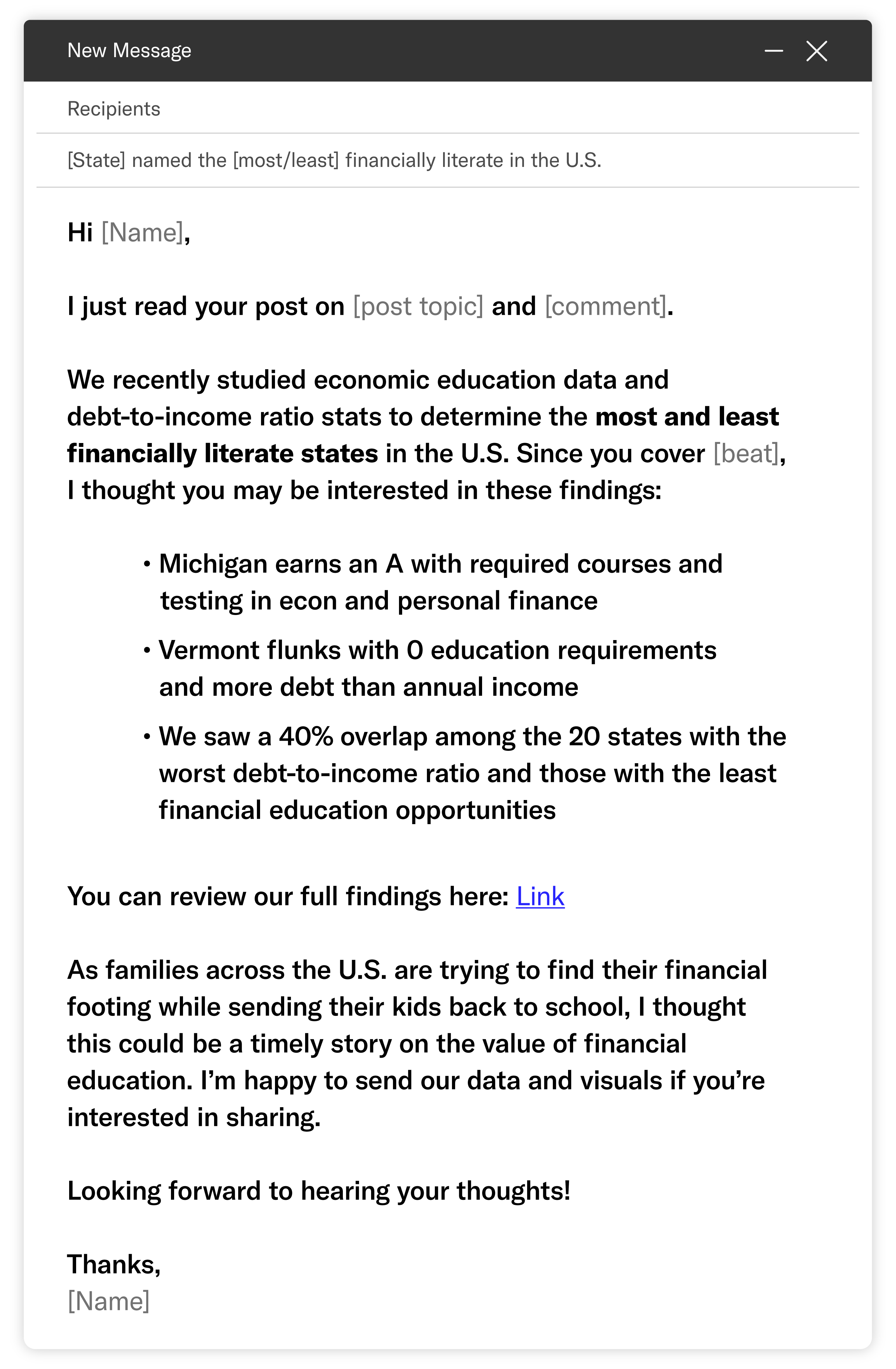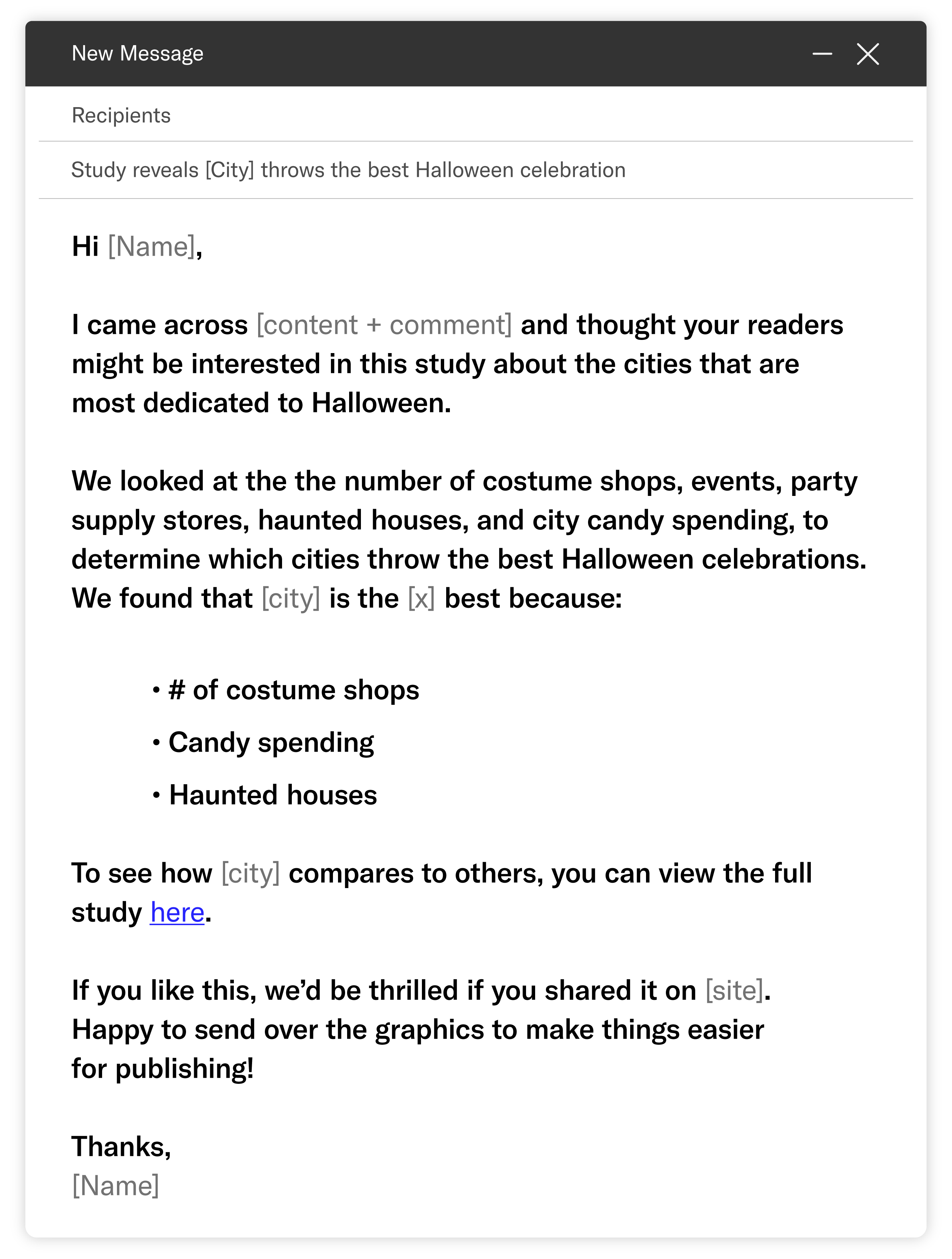Link building is a lot like being quoted in a news article or cited in academic research. The more it happens, the more people view you as an authority. The same is true for websites.
Businesses that incorporate link building into their content marketing strategy report a 45% higher success rate than those that don’t (Siege Media + Clearscope). To make sure your site has a fighting chance to rank and secure valuable clicks, you need to develop a link building plan of action.
After perfecting our link building strategy for a while, we’ve now found our sweet spot.
We’ve stopped most manual link building to focus mainly on building links organically — no outreach involved. This has allowed us to double our content production of the same quality content, and still generate links that are future-proof.
That said, there are still a range of link building strategies we’ll cover in this post, including:
- Use Social Media
- Perform Broken Link Building
- Look at Competitors’ Links
- Make Your Website More Visible
- Keep Track of Your Links
- Share Your Content on Forums
- Try Link Reclamation
- Consider Guest Blogging
- Focus on Passive Links
- Include Infographics
- Target Resource Pages
- Create Roundup Posts
- Consider Newsjacking
- Create Surveys
- Collaborate With Opinion Leaders
- Release Data Studies
- Conduct City Studies
These link building strategies are a mix of both organic link building and manual outreach tips for you to consider based on your experience and available time. Plus, we added some email templates you can use with these strategies.
Ready to build links?
1. Use Social Media
A more roundabout way to increase incoming links is to get active on social media and engage regularly with reporters and bloggers in your niche.
Creating and building an online presence for your brand will increase your audience size, boost page views, and can even lead to new links over time.
Here are some tips when using social media for link building:
- Use hashtags strategically: Say a reporter searches for a hashtag on Twitter, and you used that same hashtag to tweet about a recent study you wrote. You might get coverage from that tweet.
- Find journalist requesting data: Journalists even use Twitter to request data, so monitor hashtags like #journorequest or #prrequest for linking opportunities that fit your brand.
- Actively engage on industry platforms: Commenting on others’ blog posts is another strategy you can implement to boost your brand awareness.
These strategies not only show that you are an active participant in industry conversations, but also help you build a relationship with other bloggers who may reach out to you for coverage in the future.
2. Perform Broken Link Building
Broken link building — also known as BLB — is a strategy that helps secure links on resource pages by finding broken links currently listed and suggesting your post as an alternative.
It’s a relatively easy way to earn links because after you’ve created your piece of content, most of the work is off your plate.
You’ll want to create a guide that covers a topic relevant to your site in order to get links that prove your value and will be an alternative for that broken link. For example, as a content marketing agency, creating a list of free data sources will bring value to other content creators looking to level up their pieces with relevant statistics.
When beginning your BLB research, there are search modifiers you can add to your keywords to filter out irrelevant pages. Examples include:
- Inurl:resources
- Inurl:links
- Inurl:useful-links
When used in tandem with topical keywords, you can start your search for potential prospects on the right foot. But what exactly do you say once you find a good prospect? We’re glad you asked.
BLB Outreach Template
Here is an example outreach email from a BLB campaign that had an average 68% open rate and a 36% click-through rate.
This email works because it gets straight to the point.
Not only does this keep prospects from bouncing off your email, it also makes customization easier on you. Make sure to link to the prospect’s resource page in the body of the email so it’s easier for both of you to return to it as needed.
3. Look at Competitors’ Links
One good way to find out which link building strategy works for your type of content is by doing some “spying” on your competitors by looking at your competitor’s links, also known as backlinks.
And as a bonus, this helps you understand the type of content your audience enjoys and links to the most — which in turn helps you write with SEO in mind.
There are a couple of ways you can do this. By using a tool such as Ahrefs, you can:
- Look at your competitors’ top pages to learn what type of content brings them the most traffic and which keywords they’re targeting.
- Look at your competitors’ links to learn which pages get the most links and who’s linking to them the most.
- Look at your competitors’ posts to learn what type of content and which keywords are ranking the highest to get some inspiration.
When analyzing your competitors’ posts, ask yourself these questions:
- Are they doing guest blogging?
- What post format seems to be the most effective?
- Which pages and markets are linking to them?
- Which keywords are they targeting?
This way, you’ll not only have a better understanding of the type of content to create that will generate links, but also which markets and websites to reach out to. You can then perform outreach, targeting markets and sites that link to your competitors the most.
Keep in mind that if you’re seeing a lot of placements on high-value websites, like CNN or Forbes, your competitors are likely doing paid placements.
4. Make Your Website More Visible
If you want to build more links to your website, you need to also build a personal brand and increase your visibility.
One way to do that is by investing your time in off-page SEO, which consists of optimization strategies not directly made to your website, such as local citations and fixing broken links.
Some of these strategies include:
- Ensuring third-party citations are accurate and consistent: Double-check information like your name, address, and phone number are correct.
- Creating and maintaining your Google My Business listing: If your business has a physical address, create a listing on Google and update the information regularly.
- Claiming your listing on popular user-generated content sites: Contact the site to claim your business and provide them with the right information.
- Improving the public perception of your brand: Invest in digital PR, social media marketing, influencer marketing, and review management.
5. Keep Track of Your Links
If you’re like us, you’re probably guilty of checking for new links at least once a week — or maybe every day, but we won’t judge.
Aside from ensuring you have a healthy backlink profile, keeping track of your links helps you understand who is contributing to your backlink profile, meaning who links to your site. This way, you’ll be able to focus on relevant industries when performing outreach and creating content.
There’s also a thing called link relevancy, which is even more important than the authority of those who link to you.
That’s because when you have relevant links, you’re telling Google that you’re a trusted source for your industry. This helps you rank for terms that are important to your business.
6. Share Your Content on Forums
Forums are a great way to find answers to your questions and connect with people online. They can also be a useful link building strategy since they provide a valuable way to get more traffic to your blog post, which increases the chances of people linking to you.
When sharing your content on forums, it’s important not to just link to your post and hope for the best. After all, forums usually have rules and common practices to follow, and you need to abide by them.
When sharing your post on forums, you should:
- Add to the conversation by answering comments.
- Give tips and advice.
- Follow the forum rules.
- Link to your post as an extra resource.
To find forums to post on, start by searching for topics or common questions people ask related to your industry. Alternatively, you can make a habit of browsing through forums related to your topic.
You can engage on forums such as:
- Quora
- Facebook Pages
As a bonus, browsing through forums might spike your creativity and introduce you to new topics and keywords to write about.
7. Try Link Reclamation
Link reclamation is the process of reclaiming lost or unlinked organic mentions to your site.
While this strategy is most successful for bigger brands that get a lot of press coverage, you can still see positive results as a smaller website.
There are two tactics for link reclamation:
- Reclaiming a lost link: If a website used to link to your site but removed the link later, there’s a possibility you can reach out to resecure that coverage.
- Correcting un-linked organic mentions: If a website mentions your brand name but doesn’t link to it, email them and ask for proper credit to a relevant page.
Link Reclamation Outreach Template
Below is an example email that can lead to a 68% open rate when customized properly.
To take your link reclamation strategy to the next level and execute lesser-known link moves, check out our advanced link reclamation blog post.
8. Consider Guest Blogging
Likely the strategy you’ve heard about the most and probably even tried yourself, guest blogging is another great way to earn mid- to top-tier links back to your site.
You might’ve heard that Google warns against guest posting, but that doesn’t mean you need to stay away from it entirely. The new version of guest posting is all about intention.
Approach your guest posting strategy with an intent to educate, and look for sites that share outside content without advertising guest posting opportunities.
Within that realm, you’ll find mid- to top-tier sites with topical relevance that will likely accept great content.
Reaching out to a site that doesn’t explicitly ask for pitches can be tricky. With these outreach emails, it’s important to highlight why their readers should care about your content.
Guest Blogging Outreach Template
Below is a sample template you can use to get started.
Once you start getting some bites, the next task is writing up the guest post.
Make sure to highlight the most important findings from your original post, but don’t duplicate copy word for word — Google frowns upon that. Instead, make your copy unique and authoritative by focusing on the new audience you’re speaking to.
9. Focus on Passive Links
At Siege, we’ve learned that on average, the cost per link of search-driven posts on an 18-month timeline was significantly better than link-driven posts. The main strategy behind this process is to find topics that have strong passive link intent, and then watch all the organic links wash in.
As a rough indicator, look for topics you or your competitors rank for on Ahrefs’ Top Pages view that have a high number of links. If it has traffic and a good number of links, that’s a strong first indicator that it has passive link intent.
From there, you’ll want to confirm that the links are steadily building, as opposed to building through a big spike or manual campaign.
If you see a gradual graph, that’s a good sign that if you can get ranking, you’ll generate passive links to your domain.
For more on this process, we recommend watching the following video where we break down additional passive link generation strategies:
10. Include Infographics
Creating beautifully designed infographics can be a good way to secure valuable links on a weekly basis. And when coupled with informative and interesting articles, infographics make great fodder for guest posts.
Using infographics as an addition to your informative post — rather than the main part of the post itself — means you’re likely to get more topical links from bloggers rather than the typical (highly penalized) infographic farm sites.
A well-designed and maybe even animated asset, like this example from CleverTap, helps take your infographic pitch to the next level and encourages a quicker share. You can highlight your design asset in your pitch, too.
Outreach Template With Infographic Template
Highlight the infographic from your post when performing outreach. This way, you can offer websites a chance to share your infographic that will link back to your post.
In the outreach email, mention what your post covers and include only a sneak peek of the infographic to prompt the prospect to click on it.
11. Target Resource Pages
Creating informative and unique content means you can also target pages looking to share your post as a resource.
This works especially well for content revolving around beginner “how-to” and “what is” topics.
These types of posts tend to be longer, overviewing everything you need to know about a topic. For example, Zola’s post on how to plan a wedding is a great addition to a resource page for wedding planners.
After creating your resource post, you can start to look for websites that have a resource page that could link it.
To do this, search for pages using search modifiers together with your keyword. For example:
- Inurl:resources
- Intitle:resource page
- Intitle:helpful links
Resource Page Outreach Template
When reaching out to prospects, mention that you found their resource page helpful and that you have another resource you think could add value to their page.
In the outreach email, mention what your post covers and include only a sneak peek of the infographic to prompt the prospect to click on it.
12. Create Roundup Posts
From the best savings tips to ways to style your hair, roundup posts can provide great inspiration to readers. What’s even better is that they’re also great in terms of shareability, just like many of the link building strategies on our list.
When creating a roundup post, you want to break away from linking to only your own posts, and try linking to other trustworthy websites.
This way, if your content is high quality, the websites you linked to might share your article with their audience.
To find some ideas for roundup posts, add search modifiers to your keyword or niche, such as:
- Intitle:roundup
- Intitle:best
- Intitle:top
You can then increase your chances of getting links by reaching out to the websites you linked to.
Roundup Post Outreach Template
When emailing prospects, mention that they were featured in your recent article and ask if they’d like to share it with their audience.
13. Consider Newsjacking
Newsjacking is a link building digital PR tactic that involves spotting opportunities in the news and creating relevant content with your added opinions and thoughts — and usually promoting your or your client’s work while doing so.
This strategy works because more people will be searching for the topic and it helps build expertise and trust, especially if you have credible people giving insights and offering tips.
But this also means you will have to keep tabs on industry news, podcasts, and roundups and create content quickly — news stories generally only last 24-72 hours!
Newsjacking works for many different industries, from finance to lifestyle. It’s just a matter of keeping up with current events and being able to relate it to your content.
For example, if your client sells mattresses and there’s some newsworthy buzz around quality sleep and mental health, you can create a post on how their mattress affects quality of sleep.
To increase your chance of earning links to your newsjacking piece, you can also perform outreach and target news websites that would cover your story.
14. Create Surveys
Ever see a survey from a small company that goes viral and think: How did they do it? Surveys can be hard to get right, since they require time and sometimes lead to irrelevant results. But when they work, it can pay off in droves.
Survey content works for several reasons:
- You get to pitch completely organic and unique data.
- You can make sure your questions directly tie to your brand’s offerings.
- You can break out your data by demographics for more targeted results.
Journalists want to cover stories that will engage their audience. That means the key takeaway from your survey needs to be attention-grabbing.
And while you should always have an end goal in mind when creating a survey, it’s important to remember that the results may not always be what you hoped for.
Even so, don’t be afraid to work with the data to find another story that captivates or use external data to back up your point.
How They Did It
This survey from Tommy John on American hygiene habits hits all the marks.
First, it draws readers in with an attention-grabbing headline. It also uses external data to back up their points and keep readers interested in learning more. And with 370+ links and counting, it’s safe to say this method works.
Interested in learning how to craft and pitch the perfect survey? Learn straight from our team with our content marketing course, SiegeLearn.
15. Collaborate With Opinion Leaders
Collaborating with people with a media footprint, whether it’s someone well known in your industry or even an influencer, can also be a good way to get your content seen.
This can increase your chances of getting links. Additionally, leveraging expert knowledge and experience puts more credibility behind your content.
You can, for example, add linkable expert quotes and statistics throughout your post to complement the content and make it easier for people to share it. Another option is to add images with expert quotes, similar to this post from Varonis.
This is a link building strategy that will work better if you have networking experience or connections with thought leaders in your industry.
But you can still level up your content by sourcing expert quotes on HARO or Qwoted. You can then reach out to let them know their advice was featured in your article.
16. Release Data Studies
Data studies use external or internal data points to tell a compelling story. Generally, data studies work best for bigger brands whose offerings are closely related to the topic of the study.
Put yourself in the shoes of a reporter. If the brand pitching you is an insurance company, for example, does it make sense for them to be talking about the eating habits of consumers? Not really.
Journalists and bloggers want to share data from certified experts, so it’s important that your study reflects what your brand is all about.
Data Study Outreach Template
When reaching out to reporters for data studies, keeping it short and to the point is your best route to coverage.
Highlight key findings in bullet points, and let the journalists know why they should care. Then, link to your piece to let them read more if they want, just like in the example below.
In the outreach email, mention what your post covers and include only a sneak peek of the infographic to prompt the prospect to click on it.
17. Conduct City Studies
A city study is a link building strategy that uses data from specific regions to make a statement about the people, businesses, or even weather patterns.
City studies often have great open and click-through rates as they are highly relevant to the journalists and bloggers in the region.
With city studies, you’re able to target specific regions with topical information. This can help garner unique links to news outlets, resource pages, and blogs for different cities.
You can also use city studies to get links back to your location-specific product pages (if you have them) as they’ll be useful for readers in that area. Talk about a win-win!
City Study Outreach Template
When doing outreach for city studies, customization is extremely important. Consider targeting the top five cities on your list, and customize each email to the journalists’ previous articles.
This way, they know that not only are you sending hyper-relevant content, but you took the time to read their previous work to make sure your pitch was a good fit for their beat. A template city study outreach email looks something like this.
Link Building Best Practices
There are a lot of options when it comes to link building strategies, but there isn’t a one-size-fits-all solution.
To ensure you’re getting the most out of your efforts, remember to follow these link building best practices:
- Create useful and quality content that will make people want to share it.
- Get to know your audience in order to attract the right people.
- Reach out to websites that are relevant to your content.
- Understand what your competition is doing well.
- Use social media and forums to bring more eyes to your page.
- Find websites that will link to you by using a link building scorecard.
In order to be successful in this area of content marketing and SEO, your brand’s authority, goals, and time constraints must all be taken into account before getting started.
But with an ever-changing industry, it can be hard to adapt. We believe that partnering up with a team of industry experts is the best way to create content that leads to scalable link acquisition.


